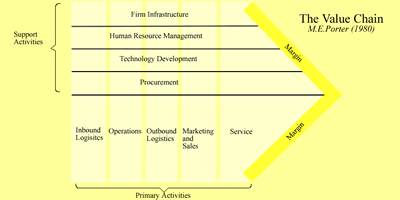Value Chain Analysis
The value chain is a systematic approach to examining the development of competitive advantage. It was created by M. E. Porter in his book, Competitive Advantage (1980). The chain consists of a series of activities that create and build value. They culminate in the total value delivered by an organisation.
Support Activities.
Procurement.
This function is responsible for all purchasing of goods, services and materials. The aim is to secure the lowest possible price for purchases of the highest possible quality. They will be responsible for outsourcing (components or operations that would normally be done in-house are done by other organisations), and ePurchasing (using IT and web-based technologies to achieve procurement aims).
Technology Development.
Technology is an important source of competitive advantage. Companies need to innovate to reduce costs and to protect and sustain competitive advantage. This could include production technology, Internet marketing activities, lean manufacturing, Customer Relationship Management (CRM), and many other technological developments.
Human Resource Management (HRM).
Employees are an expensive and vital resource. An organisation would manage recruitment and s election, training and development, and rewards and remuneration. The mission and objectives of the organisation would be driving force behind the HRM strategy.
Firm Infrastructure.
This activity includes and is driven by corporate or strategic planning. It includes the Management Information System (MIS), and other mechanisms for planning and control such as the accounting department.
The ‘margin’ depicted in the diagram is the same as added value. The organisation is split into ‘primary activities’ and ‘support activities.’ Also see value curve.
Primary Activities.
Inbound Logistics.
Here goods are received from a company’s suppliers. They are stored until they are needed on the production/assembly line. Goods are moved around the organisation.
Operations.
This is where goods are manufactured or assembled. Individual operations could include room service in an hotel, packing of books/videos/games by an online retailer, or the final tune for a new car’s engine.

Outbound Logistics.
The goods are now finished, and they need to be sent along the supply chain to wholesalers, retailers or the final consumer.
Marketing and Sales.
In true customer orientated fashion, at this stage the organisation prepares the offering to meet the needs of targeted customers. This area focuses strongly upon marketing communications and the promotions mix.
Service.
This includes all areas of service such as installation, after-sales service, complaints handling, training and so on.
